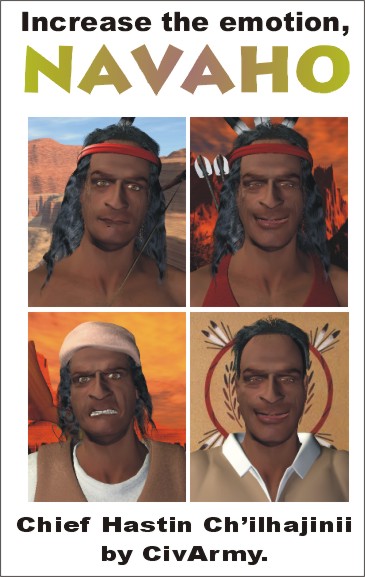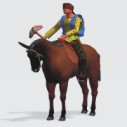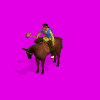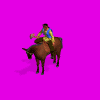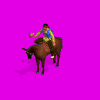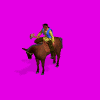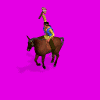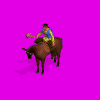Thanks to SoG, Mobilize, Jorde, DPII and others for have given to me cool tips
 'Download File' link contains half of this leaderhead pack, download the other half here:
'Download File' link contains half of this leaderhead pack, download the other half here:  http://www.civfanatics.net/downloads/civ3/civs/navaho02.zip
Civilization:
http://www.civfanatics.net/downloads/civ3/civs/navaho02.zip
Civilization: Navaho
Bonuses: Commercial and Religious
Title and leader: Chief Hastin Ch'ilhajinii
Best/shunned government: Despotism and Monarchy
Agression: 02 (low)
Cultural group: American.
Noun: Navaho
Adjective: Navaho
Colors: Light Blue (Spain) and Blue (Persian).
UU: Desert Wind
Civilopedia entry: RACE_NAVAHO
Cities:
Ta chee
Sis na' jin
Tse nee tat
Ash chee
Tqo toda sihee
Dzil na'odili
Tse dzinki'ni
Haskendine
Tqo dzil
Tse'tlani
Nat ege saka'te
Tsa ya hat tso
Carrizos
Tqo hee tle
Zuni
Tohatchi
Mancos
Tsa ha gaye
Tse'hoghan
To'waya'lane
Taaitalone
Chol'i'i
Tqo bit'cloch
Tse'the neesa'en
To dotsos
Tqo yah ha'tline
Military leaders:
Na'yei na'zone
Nai'dikisi
Tqo bajishchini
Bad'ni
Tqo toko je
Scientific ones:
Yol'gai esdzan
Hasjejine
Ba'ches chini
Hasjelti
Hasjohon
Civilopedia:
Civilopedia entry by Sword of Geddon
The Navaho people (or Diné), like the Apaches, are of Athapaskan descent and probably migrated south to the American Southwest about 1300, although archaeological evidence suggests that some Athapaskan-speaking tribes arrived in the Four Corners region of Arizona, New Mexico, Colorado and Utah as early as the 8th century. Oral tradition holds that the ancestors of the Navahos were already in Dinétah (the traditional Navaho homeland) when the Anasazi were building in Chaco Canyon between the years 900 and 1130.
The Navaho conflicts that led up to the Long Walk began with the Spanish conquest of the Southwest in the 16th century. Before the Conquistadors arrived, the early Navahos apparently coexisted with their Pueblo Indian neighbors fairly well, though raids were sometimes carried out. The Navahos, seminomadic hunters, adopted some Pueblo culture and learned farming from the Pueblo tribes. Spanish missionaries had almost no success with the Navahos, but the Navahos did take an interest in Spanish horses and guns and, as a result, their interest in raiding grew. Sometimes the Navahos raided the Spanish colonists, and sometimes they traded with them. But they were far enough away not to feel too threatened by the Spaniards.
The Pueblo Indians had it worse. Spanish soldiers and priests were living among them, forcing the Indians to forego their traditions and to worship the Spanish God. To seek refuge from their heavy-handed masters, some Pueblos ran off to join the
Navahos.
In 1680, the Pueblo people revolted against their Spanish masters and drove them away from New Mexico, but all their problems did not disappear with the Spaniards. The Navahos, mounted on horses, increasingly raided Pueblo villages. In some cases, Spanish soldiers had been providing protection from these raids. Not that the Pueblo Indians wanted the white men to return, but return they did in 1692. When the Spanish reconquered New Mexico, many Pueblos again fled to live with friendly Navaho bands. This cultural mix led to the Navahos’ learning many new things, including how to raise sheep and goats. In time, as the Spaniards took a kinder approach to the Pueblo Indians, many of the Pueblo families that had taken up residence in Dinétah returned to their pueblo homes. By the early 1700s, most Pueblos were siding with the Spaniards, who could help fight off Navaho, Apache and Ute raiders. At the same time, the Spanish, sometimes with Pueblo assistance, were busy capturing Navaho women, children and livestock. By the end of the 18th century, the Navahos were also dealing with equally troubling raids by Utes, Comanches, Jicarilla Apaches and Mescalero Apaches. Many Navahos packed up and drove their flocks to more peaceful grazing grounds to the west.
Desert Wind, the UU:
This unit replaces Horse, has one extra movement per turn, one extra offensive point and cost 10 shields more.
Desert Wind is the fantasy name of the most important military unit of the Navaho civilization. The first contact with horses happened in XVII century, when Spanish has brought horses to the American continent. Horses brought a revolution to the Navaho society, in its army and all other aspects of the civilization.
Icon
Default
Run
Death
Victory
Attack
Forfify



